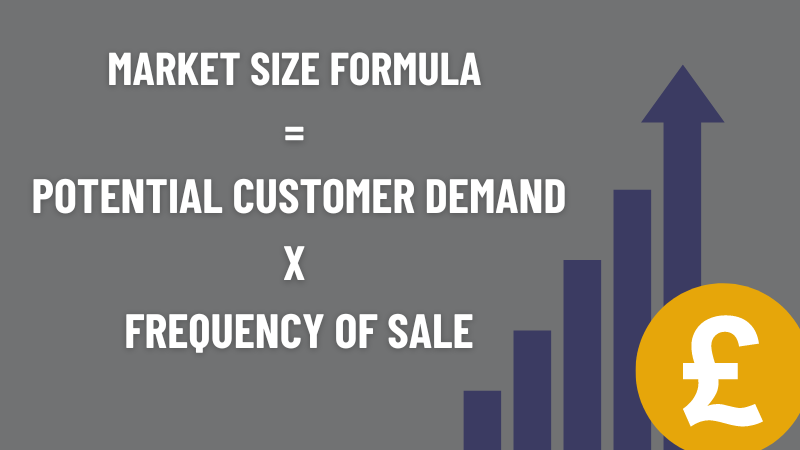Categories
Market Size Formula | Step by Step Calculation

When considering a new business or launching a new product, understanding its chances of success is essential.
One of the most important metrics in determining whether there is a need for your business idea is to calculate the market size - only by doing so can you work out if there are really enough customers for your product or service.
But how do you calculate market size? Is there a simple market size formula to give you an edge?
Table of Contents
Understanding Market Size and its Role
How is Market Size Determined? 7 Steps
- 1. Understanding Your Demographic
- 2. Market Research - Sizing Your Demographic
- 3. Understand Your Industry and Competition
- 4. Determine The Sale Frequency of Your Offering
- 5. Be Realistic About Interest and Demand
- 6. The Market Size Formula
- 7. The Market Size Value Formula
How to Use Market Size
Understanding Market Size and its Role
You may be wondering ‘what is market size?’ - not an unreasonable question. Market size is an evaluation of the total number of potential customers who would buy your business offering. It’s an indicator of how many sales you could make and, by extension, the level of income your business is capable of making.
Calculating market size is a key part to your business planning. If you do it incorrectly then you could be investing your time and money into a venture that’s doomed to failure, so it’s worth giving it your full attention and working our your market size accurately.
Evaluating the market size for your product or service is also an important step on the way to obtaining early business funding. Lenders will want to see your market size calculation in your business plan as part of your startup funding; while investors will pour over this detail before considering your business for venture capital.
More importantly than lenders or investors, however, you will want to know your market size before embarking on a significant enterprise that will become your central career focus for the foreseeable future.
How is Market Size Determined? 7 Steps
There is a market size formula - a simple mechanic for determining the size of your potential market, but before we discuss this specific, it’s worthwhile understanding the data that goes into the process.
Predictions like this are designed to mitigate risk and provide a metric that enables you and others to make informed decisions rather than pure guesses.
1. Understanding Your Demographic
The first step is to define and properly understand your target audience - commonly known as a demographic.
A market demographic is the particular section of the population who form your potential customers.
For example, if you are making cute mobile phone cases, then your demographic becomes the set of people who both have mobile phones (quite a considerable size and range), and enjoy a cute aesthetic (typically younger adults and children).
Conversely, if your product is a paper magazine about knitting, then your demographic likely will be comprised of older people and skewed towards women.
Many successful businesses do seek to break these stereotypes, but they have to understand their market size may consequently be limited.
When determining your demographic, consider:
- Age
- Gender
- Location
- Education
- Economic background
- Income
- Family status
- and more…
2. Market Research - Sizing Your Demographic
The next step, and one that can be complex and time consuming, is researching your demographic to determine its size. Using our previous examples, the phone case business would be interested in knowing the number of 12 to 30 year olds in the UK, as well as statistics on how many favour cartoon characters, or perhaps have an interest in cats. The knitting magazine would do well to research the number of retirees in the local area, especially women.
There are plenty of places you can go to find the figures you are after, though some of them will take a bit of digging. One invaluable source for UK businesses is the Office of National Statistics (ONS) where you can find data based on the last census and a lot more. It can take a little practice to extract the information you want from the ONS, but it is there to get.


3. Understand Your Industry and Competition
Unless your business idea truly is unique, you will have some competition (and even if it is unique, there will be crossover with other companies competing for your customers’ money).
Researching your industry (again, the ONS is good for this) helps you calculate how much of the market you will reach. Very competitive industries or those with a clear market leader may mean you get a much smaller cut of the pie, so you need to ensure the pie is large enough to share.
4. Determine The Sale Frequency of Your Offering
What product or service are you offering and how likely are people to buy it? That’s a key question that crops up at this stage.
In the phone case example, each customer may buy a single phone case each year.
There will be instances of customers coming back every six months, and there may even be a few rare ones who buy a new phone case from you each month, but equally some customers will never return and others may only come back after a few years.
The knitting magazine, on the other hand, is a monthly release and is likely to enjoy subscriptions where 12 copies are sold a year. Again, though, some customers will dip in only every now and then, and no one is purchasing more than twelve, so it’s likely the actual average frequency of purchase is closer to 6 per year.
Determining the sale frequency of your offering is an important step to calculating market size.

5. Be Realistic About Interest and Demand
The final stage is to consider interest and demand, factoring in the earlier research regarding competition.
Let’s suppose, for the knitting magazine, that the demographic research indicates there are 200,000 potential customers who are fans of knitting, of the right age and gender bracket, and in the target area; but another magazine already exists to which 20% of these potential customers already subscribe. Perhaps one quarter of the existing magazine readers will be interested in the new offering in the market, plus approximately one tenth of the remaining total.
Looking to the other example. Based on an internet sales model, the number of potential customers in the UK eager to buy a cute phone case could be significant, reaching 10 million. However, the competition is high and a new venture would be pleased to sell to even 1% of these. That indicates a demand of 100,000 potential customers.
It’s important to be realistic and conservative when you are calculating demand, but don’t sell yourself too short. Conduct further market research if possible, with surveys and other techniques to gather as much primary data as possible.
6. The Market Size Formula
With all the data gathered, the market size formula is as follows:
For the magazine example, market size is equal to 26,000 x 6 = 156,000. This represents the number of magazines sold per year.
For the phone case business, market size is 100,000 x 1 = 100,000; an annual sale of one hundred thousand cute phone cases.
7. The Market Size Value Formula
Market size value looks at the gross income that would be generated by this market, based on the sale price of each unit, as follows:
With a unit sale price of £12, the phone case business would project an annual market size value (turnover) of 100,000 x 12 = £1,200,000.
The magazine is planned to list at £7 per issue, representing a market size value of 156,000 x 7 = £1,092,000.
How to Use Market Size
Calculating market size and its value provides you with some important data for your business that has several advantages:
Business Viability
Only once you have calculated market size can you really evaluate the viability of your business idea. Until this point, everything has been guesswork and speculation; numbers plucked from the air. With solid research and clear use of the market size formula, you know whether the business is viable or not.
Business Plan Legitimacy
Alongside viability is the knowledge that your business plan is a legitimate document, with figures that have a basis in reality. Presenting your business plan to a third party for a business loan or investment now becomes a feasible possibility.
Investment Interest
No investor will be interested in your business until you have clearly defined market size and value. Using your figures an outside investor will be able to properly consider any proposal.

Lender Acceptance
Like investors, banks and other financial institutions will take you more seriously with comprehensive market size and value figures, opening your business up to access important funding.
Future Planning
Alongside the immediate, analysing market size and reevaluating annually (or more frequently) will give you greater understanding and control of your business, leading to superior future planning and success in expansion undertakings.
Adjustability
Finally, but most importantly, by calculating market size and value, you are able to determine if your planned price point and outgoings will work.
It may be that once you have used the market size formula, you determine that your intended unit sale price is too low, or that your idea needs to not be so niche.
Perhaps, in our example, the phone case company realises they shouldn’t limit themselves to cute phone cases, but should do a range that appeals to a wider demographic; maybe the knitting magazine raises the cover price for each issue.


















